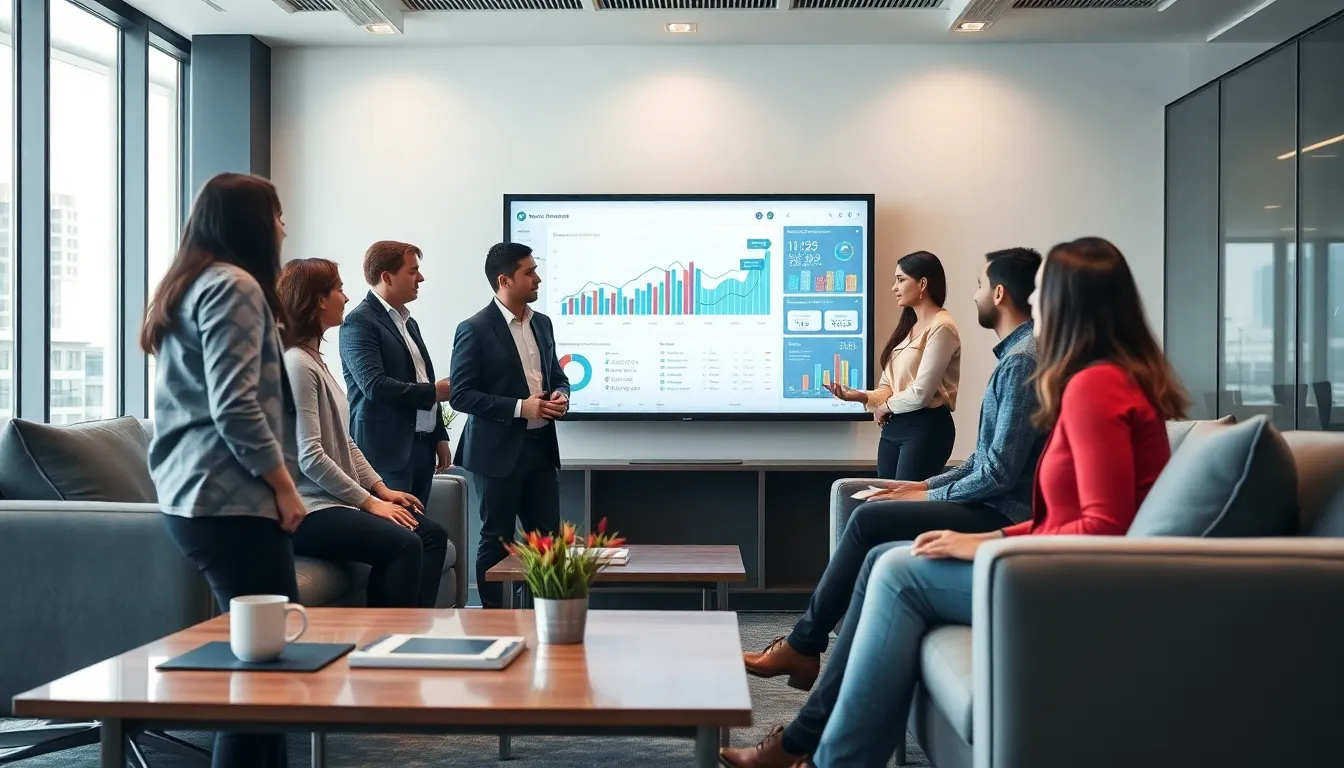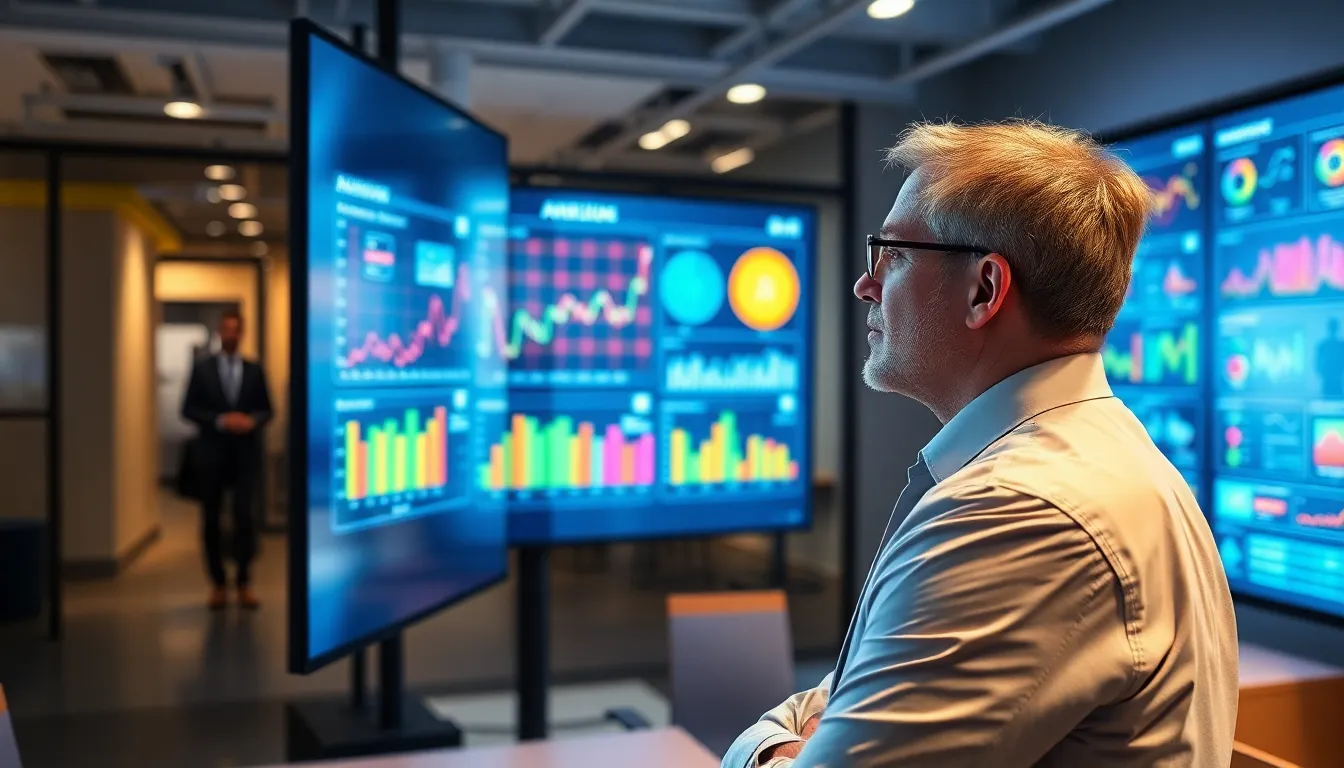In a world where everything from your toaster to your car is connected, IoT data visualization has become the superhero we didn’t know we needed. Imagine trying to make sense of a mountain of data without the flashy graphs and colorful charts—it’s like trying to find a needle in a haystack while blindfolded. With the right visualization tools, those endless streams of data transform into clear, actionable insights faster than you can say “data overload.”
As IoT devices continue to proliferate, the ability to visualize this data effectively isn’t just a luxury; it’s essential. Whether it’s tracking smart home energy usage or monitoring industrial machinery, IoT data visualization helps decision-makers see the big picture without losing their minds. So, buckle up as we dive into the fascinating world of IoT data visualization and discover how it can turn chaos into clarity.
Table of Contents
ToggleUnderstanding IoT Data Visualization
IoT data visualization transforms complex information from interconnected devices into clear graphics. This clarity enhances decision-making across various sectors.
Importance of Data Visualization in IoT
Data visualization enhances comprehension of vast IoT-generated data. Without visualization, large datasets can overwhelm users, leading to misinterpretation. Clear visuals help identify trends and outliers, enabling quick analysis. Organizations that leverage effective visualization tools gain competitive advantages by making informed decisions rapidly. Insights drawn from visuals can influence strategies and improve operational efficiency.
Key Components of IoT Data Visualization
Several components define successful IoT data visualization. First, dashboards consolidate metrics into an accessible interface. Second, data sources integrate seamlessly, consolidating information from various sensors and devices. Third, interactivity allows users to manipulate data views, enhancing the exploration of specific datasets. Fourth, real-time updates ensure users receive the most current information, essential for immediate decision-making. Finally, user-centric design caters to different audiences, ensuring the visuals are understandable for both technical and non-technical stakeholders.
Tools and Technologies for IoT Data Visualization

Various tools and technologies enhance IoT data visualization, facilitating clearer insights from complex data.
Popular Visualization Tools
Tableau stands out as a powerful tool, enabling users to create interactive and shareable dashboards. Microsoft Power BI integrates seamlessly with existing systems, allowing data storytelling. Grafana excels in monitoring and visualizing time-series data from IoT sensors. D3.js provides flexibility and customization for web-based graphics, appealing to developers. Each tool addresses unique needs, catering to both technical and non-technical audiences.
Emerging Technologies in IoT Visualization
Artificial intelligence enhances data interpretation, transforming raw data into concise narratives. Virtual reality immerses users in data environments, offering a new perspective on data analysis. Augmented reality overlays digital information onto the physical world, facilitating real-time decision-making. Cloud computing supports scalable storage and processing capabilities, efficiently managing vast IoT datasets. These emerging technologies represent significant advancements, improving clarity and interaction in IoT data visualization.
Best Practices for Effective IoT Data Visualization
Effective IoT data visualization relies on applying best practices to convey information clearly and accurately. Organizations that prioritize these practices can enhance data comprehension and facilitate better decision-making.
Design Principles for Visualizations
Establishing a clean layout significantly improves understanding. Utilize whitespace to separate elements and avoid clutter. Group related data together to create a natural flow, guiding the viewer’s eye. Color schemes should be consistent and purposeful, directing attention to critical areas. Font sizes and styles must be legible and aid in distinguishing different data types. Interactive elements, such as tooltips or filters, can enhance user engagement and exploration. Responsive designs ensure visuals adapt to various devices, allowing seamless access for all users.
Ensuring Data Accuracy and Clarity
Data accuracy remains paramount in effective visualization. Validate all data sources before integration to maintain integrity. Employ real-time updates, ensuring stakeholders access the most current information. Consider layering visuals to present multiple datasets without overwhelming the viewer. Familiarization with the audience’s needs guides the focus on relevant metrics. Tooltips and annotations add context, helping users interpret data points easily. Regular reviews of visualization effectiveness contribute to ongoing improvements, ensuring clarity remains intact throughout the data lifecycle.
Challenges in IoT Data Visualization
IoT data visualization presents several challenges that can hinder effective analysis. Identifying and addressing these issues ensures optimal clarity and understanding of complex datasets.
Data Overload and Complexity
Data overload poses a major obstacle in IoT data visualization. Large volumes of information from interconnected devices can confuse users, resulting in missed insights. Complexity of data types varies significantly across sectors, making interpretation difficult. Data visualization tools must balance detail with clarity to avoid overwhelming viewers. When presenting multiple datasets, effective layering techniques can simplify analysis while preserving essential information. Interactive elements can empower users to explore relevant data without compromising comprehension.
Security and Privacy Concerns
Security and privacy concerns significantly impact IoT data visualization. User data often contains sensitive information that requires stringent safeguards. Visualizing data without proper encryption exposes organizations to potential breaches. Privacy regulations, such as GDPR, mandate compliance, compelling businesses to implement secure practices. Effective visualization must prioritize data protection while providing meaningful insights. Organizations that fail to address these concerns risk losing credibility and trust among users. Ensuring secure connections and anonymizing personal data fosters a safer environment for data visualization.
IoT data visualization stands as a crucial element in navigating the complexities of interconnected devices. By transforming vast amounts of data into clear and actionable visuals, organizations can enhance their decision-making processes and maintain a competitive edge.
Adopting effective visualization tools not only simplifies data interpretation but also fosters a better understanding of trends and insights. As technology continues to evolve, the integration of advanced tools and best practices will further empower users to harness the full potential of their IoT datasets.
Ultimately, prioritizing clarity and user-centric design in data visualization will ensure that organizations can effectively leverage their data, driving informed decisions and fostering innovation in an increasingly data-driven world.

